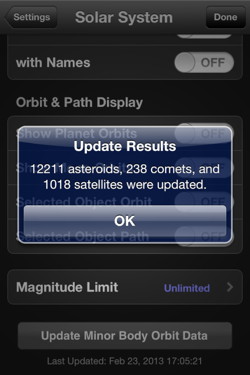
Mercury, Moon, SkySafari Pro ISS Pass, Io Transit
Posted: 24 February 2013
The observatory was opened Saturday, 23 February 2013, at 1749 MST, 63°F. The sky was clear but there was an occasional breeze. At 1805 MST, viewed the waxing gibbous moon, 77X, low in the east. At 1814 MST, one minute before sunset, viewed Mercury, 77X and 222X. A nice crescent phase was easily seen. I then began afocal imaging of Mercury using the iPhone 4 on the 8" LX200-ACF using the MX-1 adapter. Mercury was too low for good imaging, but I found one frame on a Camera app video recording, afocal 444X, that showed a fairly stable image of the crescent phase:

At 1827 MST, returned to the moon for some iPhone afocal imaging using the Camera app. Added a focal reducer and visual back, and captured this (cropped) afocal, 26mm eyepiece, image using the Camera app:

Removed the focal reducer and captured this (cropped) afocal 222X image of a portion of the terminator:

While I was imaging the moon with the iPhone, I tweeted these 6-second video loops from the observatory using the Twitter Vine app; click the images to view the videos:
At 1907 MST, I began making preparations for a low elevation pass of the International Space Station (ISS). Since the pass was too low for imaging through the telescope, I had decided I would use SkySafari Pro 3.7.3 on the iPhone 4 to control the telescope using the SkyWire serial connection. Prior to opening the observatory for this night's session, I updated the ISS (and other satellites and minor body data) in the SkySafari Settings. SkySafari then showed the ISS pass at 1930 MST.



As the time of the ISS pass approached, I connected the iPhone to the telescope, selected the ISS from the Search screen, and watched the Alt value (upper lefthand corner):

When the Altitude value reached 0.0° I tapped the GoTo button. The telescope slewed to the current location of the ISS. Unlike when using the AutoStar built-in satellite tracking capability, SkySafari did not continue to track the ISS as it moved across the sky. I had to keep tapping GoTo to catch up with the ISS. This is not a bug in SkySafari; it just does not have the capability to track moving objects. (If your telescope does not have a satellite tracking capability, using SkySafari Pro will at least get your telescope pointed in the right direction for manual tracking.)
After the pass was over, I disconnected the phone from the telescope. At 1950 MST, viewed Jupiter, 77X. There was something odd about the view of Jupiter, so I increased the magnification to 206X. Ah ha, a moon's shadow was in transit. I checked Pocket Universe on my iPhone and learned that the moon in transit was Io. Switched to 364X and had a nice view of the shadow.
I then mounted the iPhone on the telescope for afocal imaging at 444X + moon filter. At 2010 MST, I did a short video recording with the Camera app. I stacked the 762 frames of the video using Keith's Image Stacker, with this result:

The shadow of Io is visible on the South Equatorial Belt (SEB), just right of the central meridian. If you look closely, you will see the moon Io about to end its transit of Jupiter near the left limb but still over the SEB.
I also tweeted a Vine video of Jupiter, attempting to show Io's shadow (click the image to view the video):
Unfortunately, the Vine app requires a finger be touched to the device screen to do the video recording. This creates vibrations in the image. (I have pointed out this problem to the developers.) But the shadow is visible in the video.
I resumed Jupiter viewing, 364X, at 2021 MST. Io had exited the planet's disk, with the shadow still in transit.
The observatory was closed at 2036 MST, 42°F.
I have collected some of my Moon Earthshine photos into a new section on the Moon photos album page.
Comments are welcome; use the Comments section below, or you can Email Me. Thanks.
Go to the previous report.
Return to the Cassiopeia Observatory Home Page.